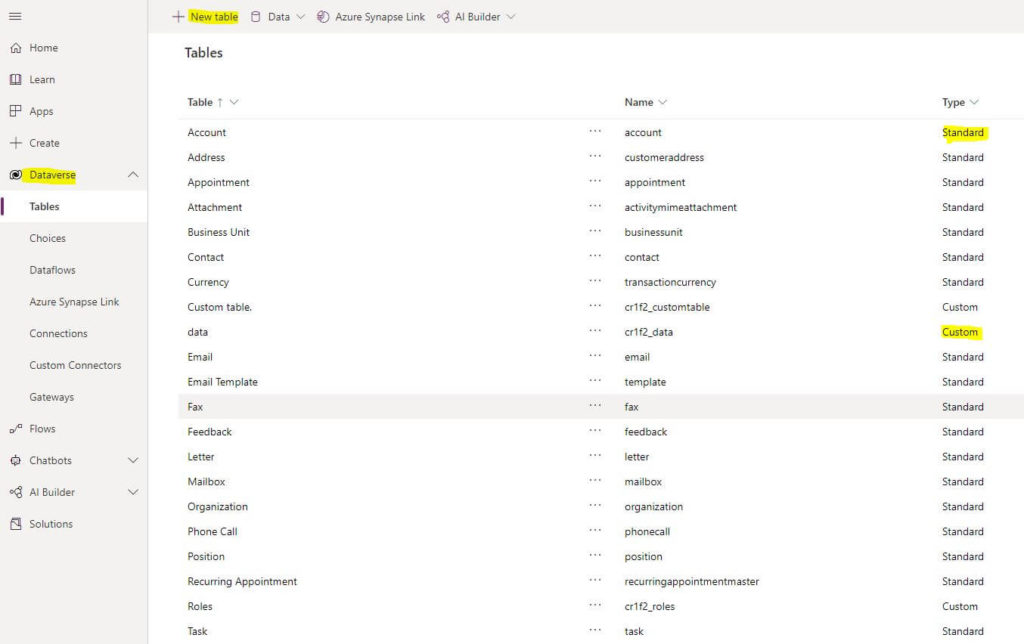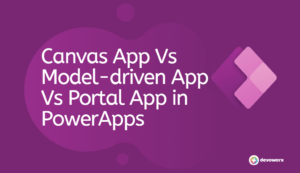In this article, we will explain the main differences between Microsoft Dataverse vs Dataverse for Teams. Also, we’ll explore the Dataverse for Teams as a relational data storage that delivers a built-in, low-code data platform that makes it simple to create and deploy apps.
Note: Microsoft Dataverse for Teams is a free edition of Dataverse with some limitations. It allows only the creation of internal apps in Teams.
Data is at the core of everything a company does now, and it fuels the insights that can help it decide what it should do in the future.
So let’s know the centralized data service “the Dataverse” in the Power Platform and perfrom a comparison between Dataverse vs Dataverse for teams.
Microsoft Dataverse

- Microsoft Dataverse is a cloud-based storage space in the platform that you can use to begin designing your data structures.
- Dataverse is designed to operate with any type of data and includes all of the key data technologies that your company need, including relational, non-relational, file, image, search, and data lakes.
- Dataverse allows you to store and manage data that is used by business applications in a safe manner.
- Role-based security is used by Dataverse to group together a set of privileges. Users can be assigned to these security responsibilities directly, or they can be assigned to Dataverse teams and business units.
- To generate, modify, and interact with data, Dataverse contains a collection of visual designers. This makes it simple to quickly define your company’s tables, connections, business rules, forms, and workflows.
- The Data is saved in a set of tables in Microsoft Dataverse.
- Dataverse comes with a number of standard tables, that you have to be familiar with to use if they meet your business needs. They will work as you expect in your environment without additional effort.
- If the standard tables didn’t meet your business need, you can create your own custom tables.

For more details, you can check out the Microsoft Dataverse article.
Dataverse for Teams

- Microsoft Data verse for Teams is a relational data storage that delivers a built-in, low-code data platform that makes it simple to create and deploy apps.
- Dataverse for Teams provides a targeted collection of features for creating applications, Flows, and more inside the Teams.
- The Data verse for Teams environment is used to store, manage, and share data, applications, and flows that are specific to a team.
- Each team has its own environment, and all data, applications, bots, and flows developed with the Power Apps app inside that team are accessible through the Dataverse for Teams database of that team.
- Each team has its own dataverse.
- If the team is deleted, the Data verse for Teams environment that was created will also be deleted.
- Most of the standard tables that are provided with a Dataverse environment won’t be present as part of Dataverse for Teams.
- Teams owners can manage team membership and settings in the team, and they have full access to the Dataverse for Teams environment’s apps, resources, and data.
- Teams members can view the Dataverse for the Teams environment’s resources, run all apps and resources, and create/ update their own resources. They have full access to all the data.
- Teams can invite guests to access the apps, bots, flows, and data in the Dataverse for Teams database within their team. They can view and run all the resources in the team. By default, guests have full access to the records they create and don’t have access to other users’ records.
- You can’t share a record with another user or team.
- You will find the Dataverse for Teams environment in the Power Platform admin center.
Microsoft Dataverse for Teams is free. You don’t have to buy an additional subscription to use it.
What are the required subscriptions that allow you to use Microsoft Dataverse for Teams for free?
Subscriptions that allows you to use Microsoft Dataverse for Teams for free:
- Office 365 E1, E3, E5, F3
- Microsoft 365 Business Basic, Standard, Premium
- Microsoft 365 F3, E3, E5
- Office 365 A3 for Faculty, A3 for Students, A5 for Faculty, A5 for Students
The Dataverse for Teams environment name is the same as the team name.

Dataverse for Teams environments won’t be allowed to change types until the upgrade operation has been carried out on the environment.
Dataverse vs Dataverse for Teams
The data in both Dataverse for Teams and Dataverse is stored within an environment. but Data verse for Teams creates a single environment for each team in Teams, so each team has its own Dataverse that they used to create apps, chatbots flows, and so on.
Here are the key features and differences between Microsoft Dataverse and Microsoft Dataverse for Teams.
Dataverse  | Data verse for Teams | |
| Types of data | Relational, File, Image, Lake, Log, Dataverse Search Virtual tables | Relational, File, or Image |
| Common Data Model | Full support | User table only |
| Capacity | No specified limit on rows. No specified limit of files or images. 2,000 API requests per day with the option of capacity add-ons. | Up to 1M rows A small number of files or images 2000 API calls per day per user |
| Security | Several standard security roles and custom roles can also be created. such as roles, business units, auditing, CMK, hierarchical/field-Level security, and so on | Owner, Member, Guest roles Share app with Azure AD group |
| Clients | Teams, Power Apps, Power Apps portals, Dynamics 365, custom code | Teams |
| Guest limitations | Must be in Azure AD using Azure B2B | Can’t make, install, or edit apps |
| Mobile offline | Yes | No |
| Managed data lake | Yes | No |
| API access | Yes | No |
| Plug-ins | Yes | No |
Power Apps component framework | Yes | No |
| Paginated reports (SQL Server Reporting Services) | Yes | No |
| Environments | Unlimited | 1 per Team |
| Maximum size | 4 TB or more | 1 million rows or 2 GB |
| Upgrade to Dataverse | N/A | Yes |
| Record sharing | Yes | No |
| Power Automate | Yes | Yes |
| Azure Synapse Link for Dataverse | Yes | No |
| SQL Server Management Studio | Yes | No |
| Events to Azure Event Hubs and Events to Azure Service Bus | Yes | No |
Conclusion
In this article, we focus on two of the most popular data technologies used in Microsoft Power Platform, Microsoft Dataverse for Teams, and Microsoft Dataverse. Teams can use Dataverse. Within Dataverse for Teams, tables allow you to create, populate, and query data. Tables represent several types of important entities in an organization.
SeeAlso
- What are Microsoft Power Apps?
- PowerApps Print Function, Forms, And Scrollable Galleries
- PowerApps Validation Examples On/before Submitting
- Share PowerApps With External Users / Guest Users
- Sign Up and use Power Apps
- PowerApps Canvas App Vs Model-driven App Vs Portal App.
- What Is Microsoft Dataverse?
- How to share Power Apps to Office 365 group
- Connectors in a Power Apps.
- Share Power Apps to external users (guest users)
- How To Create A PowerApps Custom Connector?
- How To Create Power Apps DataFlows?
- Learn Power Apps – youtube channel.


